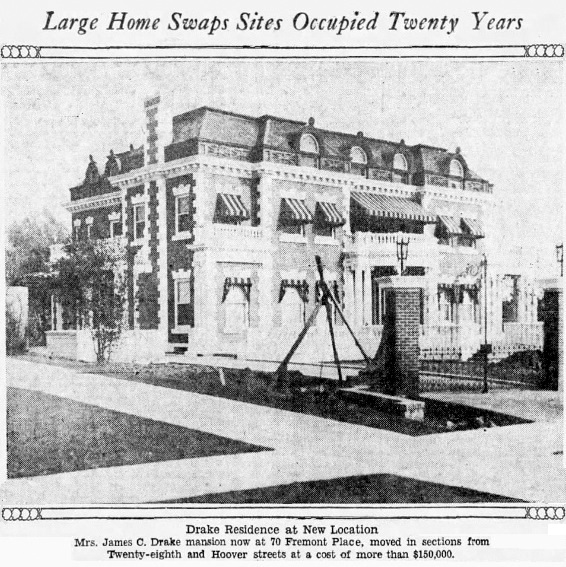2715 South Hoover Street
PLEASE ALSO SEE OUR COMPANION HISTORIES
FOR AN INTRODUCTION TO HISTORIC LOS ANGELES, CLICK HERE
In late 1909, the Los Angeles father-and-son firm of Theodore and Percy Eisen quickly came up with a solid brick block of a house, perhaps an off-the-shelf design but something seemingly immovable and relatively fireproof, for banker James Calhoun Drake and his wife, Fanny Wilcox Drake, to replace the couple's previous dwelling on the same lot at 2715 South Hoover Street, seen above circa 1906. Fire had destroyed that first 2715—built by the Drakes in 1897—only just on November 1; a building permit for the new house was issued by the city on January 14, 1910. (More on the fire and on the Drakes is here.) Mr. Drake died on March 13, 1921; in early 1931, Fanny, apparently somewhat of a force of nature capable even of moving the immovable, had the Kress Company truck the second 2715—in four pieces—to 70 Fremont Place, though she wasn't able to enjoy her new neighborhood for long, dying of a stroke that September. The Frank H. Powells were in residence from about 1938 into the mid '50s; during the '60s, the wonderfully named Zebulon P. Owingses lived there. Following her husband's death in 1967, Mrs. Owings auctioned off everything in the house and left for the East. The old Drake place was finally razed after the city issued a demolition permit on February 26, 1971; seven years later, a much less interesting dwelling rose on the site and remains there.
 |
The perspective of the architects' 1910 rendering of the new Drake house built that year at the northwest corner of Hoover and West 28th streets is interesting to compare to the photograph of the newly relocated building that appeared in the Los Angeles Times on Monday, May 11, 1931, along with a detailed article. |
George R. Kress was a Los Angeles legend by the time he moved the Drake residence, having transferred quite a number of enormous houses from commercializing and decaying districts close to downtown Los Angeles to points west. No doubt he appreciated the Widow Drake's proud extravagance during the depths of the Depression; the practice of large-house trucking had largely ceased with the Crash. Moving mansions was, not surprisingly, a high-stress job, as evidenced in this article from the Times of December 9, 1928:
 |
| As seen newly reassembled in Fremont Place, 1931 |
Illustrations: Greater Los Angeles & Southern California: Portraits & Personal Memoranda by Robert J. Burdette (Los Angeles, 1906); LAPL, LAT




